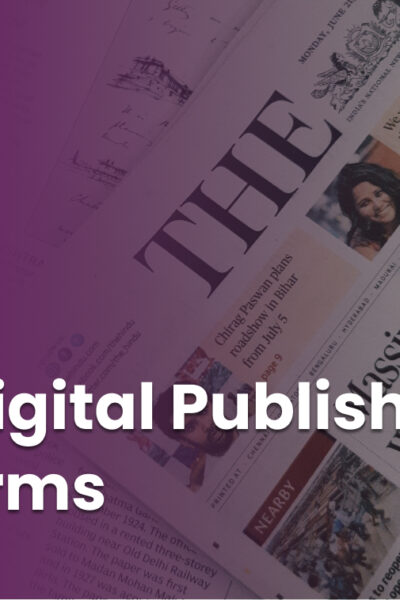The methods by which research and other academic writings are created, evaluated, disseminated and preserved — scholarly communication, is a system dates back far into human history. While many changes have taken place in scientific publishing, these functions have remained mostly the same.
The system exists as a public good to facilitate inquiry globally and, to quote a report by the European Open Science Cloud (EOSC) for the European Commission, “offer researchers the possibility of participating in a distributed system of knowledge that approximates H.G. Wells’ vision of a ‘world brain’”. As such, a substantial portion of research is funded directly or indirectly by the state. However, scientific publishing is also big business, and this has meant that the wider civic role is going largely unfulfilled.
The digital transition that has occurred in recent decades should have opened up the industry in terms of the diversity of contributors, publishing platforms and access. However, as suggested by Dave Nicholas, Director and Founder of the CIBER Research group, “it seems that the digitally fuelled developments in scholarly communication that were focused on improving on the traditional ways of conducting and disseminating research have had the unintended consequence of making the journal paper ever more ascendant”.
Big Business
In an article for The Guardian, Stephen Buranyi notes that, despite its narrow audience, the total global revenue of the scientific publishing industry is more than £19bn, putting it somewhere between the recording and film industry in size but far more profitable. The “crisis” in scholarly communication, as reported by the American Library Association (ALA), comes from the increasing consolidation of the industry whereby a few international conglomerates dominate as a result of their apparent prestige and inescapable influence. A 2015 report from the University of Montreal, quoted in the same Guardian article, revealed that the combined market share of just three publishing companies — namely, Elsevier, Springer and Wiley-Blackwell — accounted for half of the entire market.
The hegemony of these companies is reinforced by an exploitative business model in which, as stated by Peter Lyman, “ideas from universities are turned into intellectual property, then sold back to the university to be used as a common good in the library”. As stated previously, the work undertaken by scientists and scholars is largely state-funded. However, it is given to publishers for free. While some publishers will pay scientific editors to proofread and assess the work, most content is evaluated and checked for scientific validity through peer review — which is conducted by fellow academics voluntarily. The final peer-reviewed product is then sold back to the government-funded institutions and university libraries that produced it.
“Ideas from universities are turned into intellectual property, then sold back to the university to be used as a common good in the library.”
Michael Eisen, Professor of Genetics, Genomics and Development at UC Berkeley and a leading advocate of open access, asserts that “it should be a public scandal that the results of publicly-funded scientific research are not available to members of the public who are interested in, or could benefit from, such access”. In this distortion of scholarly communication, publishers “inhibit scientific and medical progress by curtailing the free flow of information upon which research depends, prevent the development of creative new ways to access and use the information contained in the literature, and deny our citizens the access they deserve to our treasury of scientific knowledge”.
The Promise of the Internet
On the digitisation of scholarship, Lyman poses that “the term scholarly communication frames both print publication and digital communication within a single functional schema, tacitly asserting a continuity between them”. While digital technologies have not disrupted the functions of scholarly communication, it has meant that the system has greatly expanded and must be recontextualised.
The internet and the possibilities opened up by computers and networks, offer unprecedented opportunities for new ways of conducting and disseminating research. Scientists and scholars separated by geography can now engage and share information with each other on a completely new level. Furthermore, the range of participants and communication channels has opened up exponentially. As Nicholas argues, “a bigger and busier marketplace is forming, containing many more and much more diverse players, products and platforms. A once strong, stable, even monolithic field appears to be transformed into a dynamic, pluralistic and fast-changing one”.
With this, the key principles of scholarly communication have broadened. The EOSC proposes “a set of principles that should characterize scholarly communication and which can help achieve an effective world brain with researchers at its centre”. These include accessibility and maximum usability to accommodate an expanding range of scholarly contributions (data, software, new documentary forms, etc.).
Additionally, given the nature of academic activities, it also needs to rest on a distributed infrastructure based on open standards to ensure access and interoperability.
This new framework for scholarly communication suggests a redistribution of power that would allow for a more fair and equitable system of sharing research outputs and the exploration of new publishing models with open access as a base. All disruptive innovation has its challenges, but digitisation offers the hope of greater access and incentive for academics to produce scientifically-pertinent research — not just what will get them published.
“The business the internet could not kill?”
In 2015 Financial Times published an article that labelled scientific publishing “the business the internet could not kill” and, in its current state, this may not be far from the truth. As explained by Eisen, the format of the industry and the business model has not changed. He argues that “this technological revolution, perhaps as significant as the invention of the printing press, has the potential to dramatically increase the impact of scientific discoveries. Yet it remains largely untapped — blocked by a publishing industry stubbornly clinging to an outdated, yet highly profitable, business model that once made sense but now stands as a significant barrier to scientific progress”.
As it stands, the unfair “reward” system has not been disrupted, and the careers of scientists and academics remain inextricably linked to the publishing industry. Many are still reliant on the reputation and status afforded by being published in high-impact journals. This “currency of prestige”, which is often translated into positions at reputable institutions, the receipt of grants or even academic tenure, continues to facilitate the status quo in which academics are both the producers and consumers of scientific content, but are not generally remunerated for their work at any stage.
The diversity of actors and multitude of publishing platforms in play has had the adverse effect of giving researchers an additional burden as the need to publish and stay relevant has greatly inflated. Informal channels, such as blogs and Medium posts, allow academics to gain greater visibility, but the true academic rewards still lie with the big publishing companies.
Lastly, the ALA points out that, as journals have moved from print to electronic form, the legal framework for their use changed from copyright law to contract law. The latter framework governs publisher licensing agreements, which often include undesirable limits on use, eliminating forms of access that would have been permitted in the print environment under principles of fair use. They add that, as the quantity and production of scholarly content have increased, the prices for scholarly journals have risen at rates well above general inflation in the economy and also above the rate of increase of library budgets. As a result, the net effect of these changes has been a significant reduction in access to scholarship. Somehow, a solution to allow open access to the scientific community and the public has achieved the opposite.
Looking Forward
While scholarly communication may have seen a frustrating lack of change, it would be fair to argue that this stage is typical of all change and technological disruption. Nicholas argues that “we are entering a transformative stage, which, introducing as it does a host of collaboration-centred and web-based emerging systems, could, possibly, challenge the hegemony of the journal”. However, there is undoubtedly a lot of work to do and a lot of shortcomings in the space that need to be addressed.
In their proposal, EOSC suggests that, in an ideal state, the infrastructure would remain open, and services would remain widely distributed so that no single organisation could achieve undue dominance over the communication system on which researchers rely. Researchers would be active contributors to shaping tools and services by a system of rewards and incentives that would take such contributions into account.
Platforms, such as Apograf, are attempting to put control back into the hands of researchers by leveraging digital technologies not just to enable but inherently promote collaboration and the proliferation of knowledge. The transparent and open system supported by distributed ledger technology offers scientists and scholars a platform to publish their work and review that of their peers based on a tokenized reward system.
Read the original article at: https://medium.com/apograf-hq/digital-trends-the-future-of-scholarly-communication-155b9adf25e5









